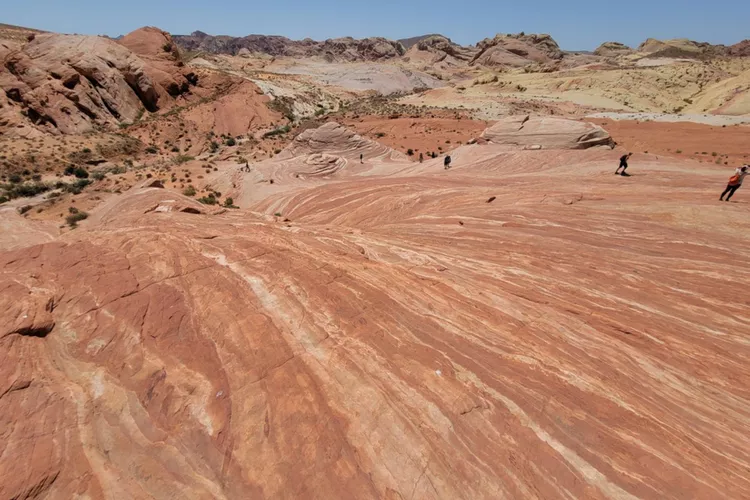1. Overview
Valley of Fire State Park offers the ultimate day trip from Las Vegas, featuring stunning red canyons, ancient petroglyphs, and breathtaking landscapes.
2. Park History
Valley of Fire State Park traces its history back millions of years to the Jurassic period. It was formed by faulting and eroding sand dunes, resulting in dramatic red rock formations rising above the Mojave Desert. It’s believed that humans occupied the region up to 11,000 years ago, though not much is known until the Basketmaker culture of the pre-ancestral Puebloans etched petroglyphs into the rocks 2,500 years ago. A short drive from the park, the excellent Lost City Museum displays tools, pottery, jewelry, and other artifacts, along with replica domiciles offering a fascinating glimpse into what their life was like.
Valley of Fire was officially designated a state park in 1935, making it the oldest and largest state park in Nevada. Before this, the area was part of the Arrowhead Highway, an auto trail predating the highway system, connecting Los Angeles and Salt Lake City. Today, the park is home to hiking trails, a visitor center, campgrounds, and a scenic byway.
3. Scenic Byway Drive
:max_bytes(150000):strip_icc():format(webp)/mountain-goat-valley-of-fire-state-park-VALLEYFIRESP0522-ce8cf04bf9ba4d569798568944b32f2d.jpg)
It’s easy to navigate around the park. A main drive called the Valley of Fire Scenic Byway connects the east and west entrances, winding through 11 miles of sculpted sandstone in brilliant shades of pink, orange, and red. Time your drive for sunset to observe the colors of the sky melting across the valley. Although Valley of Fire State Park is stunning year-round, it’s especially beautiful in the spring when the desert marigold, indigo bush, and desert mallow bloom, creating a fragrant atmosphere.
Even if hiking is not on your agenda, allow yourself an hour or two to drive the byway, with time to stop at the visitor center and interpretive displays along the way. Additionally, keep an eye out for wildlife such as desert tortoises, greater roadrunners, black-tailed jackrabbits, and desert bighorn sheep. Many of the animals in the park are nocturnal, but desert tortoises are most active in the morning, with desert bighorn sheep often seen throughout the day.
4. Hiking Trails
:max_bytes(150000):strip_icc():format(webp)/rock-formations-valley-of-fire-state-park-VALLEYFIRESP0522-6221377c42d34fc6a2847ceca2c53bfc.jpg)
Hiking in Valley of Fire State Park is akin to exploring another planet filled with swirling sand and stone. There are hikes suitable for all skill levels, and some of the easier trails are the most rewarding.
Mouse’s Tank Trail
Mouse’s Tank Trail is under one mile round-trip, making it beginner-friendly. However, even seasoned hikers will appreciate the path, which leads through a box canyon adorned with ancient petroglyphs left by the Basketmaker culture.
Atlatl Rock
The trail to Atlatl Rock is just 250 feet long, concluding at a metal staircase that leads to a viewing platform approximately 50 feet above ground, showcasing more petroglyphs. This trail is also suitable for beginners.
:max_bytes(150000):strip_icc():format(webp)/wildlife-sign-valley-of-fire-state-park-VALLEYFIRESP0522-a2e24125ffdd4b19932392b1ff1cf3de.jpg)
White Domes Trail
Also beginner-friendly, the White Domes Trail derives its name from the smooth, white sandstone formations that create a stunning contrast against the surrounding deep red formations. The loop spans a little more than one mile, meandering through sculpted slot canyons, small caves, and desert vistas.
Fire Wave Trail
The beginner-friendly Fire Wave Trail follows a sandy path to an extraordinary landscape of smooth, weathered sandstone, with slick rock swirls exhibiting alternating waves of light cream and deep pink, leading to a platform overlooking colorful striped hills.
Top of the World Arch Trail
For those seeking solitude, this challenging 4.4-mile loop guides hikers through the desert backcountry to a sandstone arch. Since it sees less traffic, it is one of the best spots in the park to observe wildlife. Be sure to carry a map or GPS device, as the path features many offshoots where navigating back to the main trail can be tricky.
5. Camping Opportunities
:max_bytes(150000):strip_icc():format(webp)/rocks-valley-of-fire-state-park-VALLEYFIRESP0522-530a50385b1c470abfaf704f3c29f9fa.jpg)
Two campgrounds within Valley of Fire State Park offer a total of 72 different units, some equipped with RV hookups. Most sites are first-come, first-served, while the three large group sites require reservations. Amenities include shared access to grills, picnic tables, showers, and bathrooms. Wi-Fi is available at the park for an additional fee.
6. Nearby Accommodations
If camping is not your preference, Valley of Fire is about 45 minutes from Las Vegas. Resorts World, owned by Hilton, is one of the newest properties on the Strip, featuring three hotels offering lodging options in various price ranges. The on-site restaurants, including Fuhu, which provides innovative Asian fusion cuisine in an indoor/outdoor ambiance, are exceptional.
Furthermore, Valley of Fire State Park is approximately 90 minutes from Hoover Dam. If you intend to visit both in one day, it is advised to start at Valley of Fire in the morning when the weather is cooler, before heading toward Hoover Dam. Conclude your day in Boulder City, which boasts a quirky store dedicated to extraterrestrial visitors, charming streets lined with breweries and restaurants, and the historic Boulder Dam Hotel.
7. Essential Tips
Before hiking the trails of Valley of Fire State Park, check the weather, as temperatures in the Mojave Desert can vary significantly throughout the year. Winter can bring freezing temperatures, while summer can exceed 100 degrees; thus, dressing appropriately is crucial. Regardless of the season, always carry water, sunscreen, and protective clothing. For those who plan to hike, sturdy shoes are essential, given that the terrain tends to be uneven.




